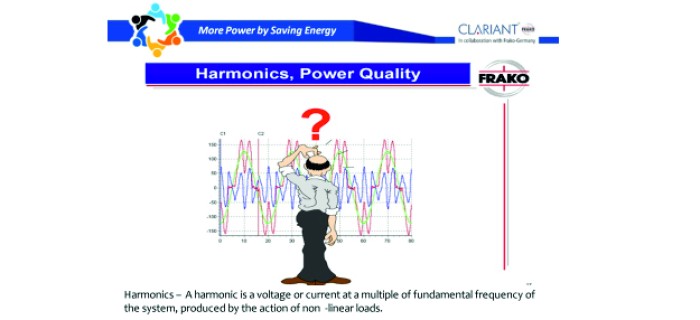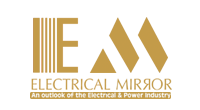
Power Quality – Best Practices Baldev Raj Narang - CEO Clariant Power System Ltd
23 Nov 2022
The loads today are predominantly nonlinear and the extent of nonlinear loads which account for about seventy percent of total loads is on the rise. The major power quality issue is generation of harmonic currents by the nonlinear loads. Various problems caused by Harmonics at load end where these are generated are - heat loss, distortion in performance parameters of electrical and electronic equipments, spurious tripping of thermal protections, overloading of neutral circuits, capacitor failures, erratic operation of controls, interference in communication circuits, and measuring errors in metering instruments etc. The adverse effects get magnified if resonance occurs due to indiscriminate use of capacitors. The harmonic currents that get exported to the grid and appear as voltage harmonics at grid end flow back to all consumers as voltage distortion and adversely affect all consumers besides causing overloading of distribution transformers of utilities. The various stakeholders involved in the management of this power quality issue are consumers, utilities, regulatory bodies, auditors, consultants, and solution providers. It is expected that all the above entities perform their functions effectively and correctly and follow best practices. We will discuss the best practices that are expected to be followed to ensure effective management of the harmonics.
Consumers :
The harmonics are generated at consumers end by nonlinearity of loads. The consumers being originators of harmonics have primary responsibility for mitigating the harmonics at their end. Harmonic mitigation solutions are needed to ensure that the export of harmonic currents to grid is within IEEE519 guidelines. To design an optimum solution a Power Quality study is needed. The desired solution is one which brings benefit to both, consumer and to the utility. If the solution is connected at PCC end it improves the performance upwards of PCC whereas there is no qualitative improvement below the PCC for equipments connected down the line. The solutions provided down the line close to nonlinear loads such as at VFDs, bring about improvement of power quality both at consumer end and also all the way upwards up to grid. The best practice for consumers is to have a judicious combination of harmonic mitigation solution that not only prevents export of current harmonics to grid but also improves the power quality within the electrical network at consumer end.
Utilities :
When we talk about utilities, we mainly mean the distribution companies. The entire generation, transmission and distribution network is clean and does not contribute to harmonic current generation. The distribution companies directly interact with consumers who are the originators of power quality distortion and export harmonic currents to the grid. The distribution companies have a major role to play in discipling as well as educating the consumers. They need to have tariff structures which are designed to provide incentives to consumers who maintain good power quality and penalize the erring consumers. The tariff structures being approved by regulatory bodies these days are designed to discipline both the consumers and the utilities alike. There are penalties to consumers exporting excessive harmonics to grid and also penalties to distribution companies exporting voltage harmonics to consumers. If the consumers default and export excessive harmonics to grid it reduces life of distribution transformers as they bear the brunt of these harmonics, and it also results in voltage distortion reflected by voltage harmonics in the grid supply voltage. Thus, distribution companies have np option but to discipline the consumers if they fail in this, they end up exporting back voltage harmonics to consumers and face penalties. On power quality front the best practice of distribution companies is to ensure effective implementation of rationalized tariff structures.
Regulatory Bodies :
The regulatory bodies have to protect the interests of both consumers and those of distribution companies. These are legal entities and have to work within legal framework and the process of decision making is very lengthy. The consumers do not invest in harmonic mitigation solutions unless they are compelled by regulations. Thus, getting rationalized tariff structures in place is the first requirement. Barring a couple of states these rationalized tariff structures are not in place. The fault lies mainly wi
th the distribution companies which are not able to effectively take up their case for approval of rationalized tariff structures. On their part regulatory bodies need to give clear, unambiguous, and impartial rulings after taking inputs from technical experts.
Technical Auditors/Consultants/ Solution Providers
Technical Auditors conduct power quality studies and make recommendations based on the observations collected during measurement of power quality parameters. Auditing is done by independent auditors or solution providers or even technical consultants. They are required to collect all the relevant data and make recommendations of optimally designed solutions. Unfortunately, in majority of the cases it does not happen the right way. It is observed that either due to ignorance or by design, unrealistic and exaggerated solutions are recommended to push sales volumes. Harmonic measurements are conducted with capacitors in ON condition and amplified values of harmonics so recorded are taken as reference to recommend unnecessarily higher rated Active Harmonic Filters. The right procedure for getting the reference harmonic current for designing harmonic filter size is to measure the harmonic current with capacitors in OFF condition as it gives the basic harmonic current value and not the amplified harmonic current value caused due to resonance by capacitors. Another equally important recommendation is for replacing plain capacitors with capacitors in series with detuned reactors. This not only avoids harmonic amplification but also mitigates some amount of harmonics. The best practice for auditors/ consultants/solution providers is to do a sincere job and recommend a correctly sized optimum solution. It is observed that many times some unscrupulous solution providers with limited technical core competence in association with small time consultants dupe gullible consumers with deceptive and faulty solutions. Some common tactics involve misrepresentation of KVAR capacities at unrealistic voltage levels, for example design voltage of capacitors for passive filter application is taken as 15.6 KV as against required value of about 13.5KV. The notional KVAR capacity at 15.6 KV is twice the realistic and effective basic KVAR at 11KV thus allowing the seller to artificially raise the cost to double. In actual practice such sellers have no intention of providing higher voltage rated capacitors and can be easily caught if capacitors are tested for voltage levels indicated on the name plate. Another tactic involves classifying 7% fifth harmonic detuned passive system as 4th harmonic tuned system to claim higher cost despite absence of 4th harmonic in the system. Such malpractices don’t work if consumers are vigilant and ensure wider participation from reputed vendors and are careful in selection of consultants.



leave your comment